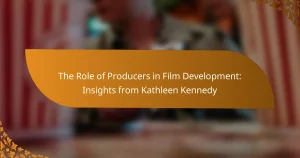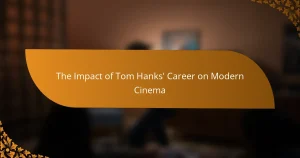
What is the Evolution of Director Christopher Nolan’s Filmmaking Style?
Christopher Nolan’s filmmaking style has evolved significantly over his career. Initially, Nolan focused on non-linear storytelling in films like “Memento” (2000). This approach captivated audiences and showcased his unique narrative techniques.
As he progressed, Nolan incorporated larger budgets and high-concept science fiction in “Inception” (2010). This film combined intricate plots with stunning visual effects, further establishing his signature style.
Nolan also began exploring themes of time and memory more deeply, as seen in “Interstellar” (2014). The emotional core of his narratives became a focal point, enhancing viewer engagement.
In recent works like “Tenet” (2020), Nolan experimented with complex time manipulation and ambitious action sequences. This marked a culmination of his distinctive style, blending intellectual depth with blockbuster appeal.
Overall, Nolan’s evolution reflects a commitment to innovative storytelling, technical mastery, and emotional resonance across his films.
How has Christopher Nolan’s approach to storytelling changed over the years?
Christopher Nolan’s approach to storytelling has evolved significantly over the years. In his early films, such as “Following” and “Memento,” he focused on non-linear narratives and psychological complexity. These films often featured intricate plots that required active audience engagement. As his career progressed, Nolan began incorporating larger themes and more expansive storytelling techniques.
In films like “Inception” and “Interstellar,” he introduced ambitious concepts related to time, dreams, and space. These works showcased a blend of intellectual depth and visual spectacle. More recently, in “Dunkirk” and “Tenet,” Nolan experimented with time manipulation and multiple perspectives, further pushing narrative boundaries.
His later films also emphasize immersive experiences, utilizing IMAX technology and practical effects. This shift reflects a desire to create not just stories, but cinematic experiences that resonate emotionally and intellectually with audiences. Overall, Nolan’s storytelling has transitioned from intricate puzzles to grand, thematic explorations while maintaining his signature complexity.
What are the key themes present in Nolan’s earlier films?
Key themes in Nolan’s earlier films include identity, time, and memory. In “Memento,” the exploration of fragmented memory drives the narrative. “The Prestige” delves into obsession and rivalry, showcasing the lengths individuals go for greatness. Themes of duality and moral ambiguity are present in “Insomnia.” Nolan’s films often challenge perceptions of reality and truth. These recurring themes contribute to his distinctive storytelling style.
How do these themes evolve in his later works?
In his later works, Christopher Nolan’s themes evolve to explore more complex psychological and philosophical concepts. His films increasingly delve into the nature of time, identity, and reality. For instance, “Inception” introduces dreams as layers of consciousness, while “Interstellar” examines time relativity and love across dimensions. Additionally, “Dunkirk” presents a non-linear narrative structure that reflects the chaos of war. Nolan’s later works also emphasize emotional depth, showcasing characters grappling with loss and sacrifice. The evolution is marked by intricate storytelling and visual innovation, demonstrating a shift towards existential themes. This progression is evident in the critical reception and thematic analysis of his filmography.
What techniques define Christopher Nolan’s distinctive filmmaking style?
Christopher Nolan’s distinctive filmmaking style is defined by non-linear narratives, practical effects, and intricate sound design. His films often feature complex storytelling that challenges viewers’ perceptions of time and reality. Nolan frequently employs IMAX cameras to enhance visual depth and immersion. He prioritizes practical effects over CGI, creating a more authentic viewing experience. The sound design in his films is meticulously crafted, often blending score and dialogue to evoke emotional responses. Additionally, he explores philosophical themes, such as identity and morality, adding layers to his narratives. These techniques contribute to the unique cinematic experience that characterizes Nolan’s work.
How does Nolan utilize non-linear narratives in his films?
Christopher Nolan utilizes non-linear narratives by structuring his films in fragmented timelines. This technique engages viewers and encourages active interpretation. In “Memento,” for instance, the story unfolds in reverse chronological order. This approach immerses the audience in the protagonist’s disorientation. In “Inception,” multiple dream layers operate simultaneously, complicating the narrative flow. Nolan’s films often feature time manipulation, as seen in “Interstellar,” where time dilation plays a crucial role. These non-linear structures enhance emotional impact and thematic depth. By challenging traditional storytelling, Nolan creates unique cinematic experiences. His use of non-linear narratives has significantly influenced modern filmmaking.
What role does visual storytelling play in his filmmaking?
Visual storytelling is central to Christopher Nolan’s filmmaking. It enhances narrative depth and emotional engagement. Nolan uses visual elements to convey complex themes without relying solely on dialogue. His films often feature non-linear narratives, where visuals guide the audience through time shifts. For example, in “Inception,” dream layers are represented through distinct visual styles. This technique immerses viewers in the story’s intricacies. Additionally, Nolan employs practical effects and innovative cinematography to create a sense of realism. His collaboration with cinematographer Hoyte van Hoytema exemplifies this approach, resulting in striking visuals that complement the narrative. Overall, visual storytelling is a critical tool for Nolan, shaping audience perception and experience.
Why is Christopher Nolan considered a pioneer in modern cinema?
Christopher Nolan is considered a pioneer in modern cinema due to his innovative storytelling techniques and use of non-linear narratives. He frequently explores complex themes such as time, memory, and identity. His films often challenge traditional narrative structures, engaging audiences in unique ways. Nolan’s work on films like “Inception” and “Memento” showcases his ability to blend commercial success with artistic ambition. He employs practical effects and immersive sound design to enhance viewer experience. Additionally, Nolan’s collaboration with Hans Zimmer on scores has redefined film music. His commitment to film preservation and the IMAX format has influenced the industry significantly. Nolan’s contributions have set new standards for cinematic storytelling and production.
What innovations has he introduced to film technology?
Christopher Nolan has introduced several innovations to film technology. He is known for his pioneering use of IMAX cameras. Nolan often shoots films with a blend of digital and film formats. He emphasizes practical effects over CGI, enhancing realism. His work on “Inception” popularized the use of rotating sets for zero-gravity scenes. Nolan’s “Dunkirk” utilized a unique three-timeline narrative structure, enhancing storytelling. He has also advanced sound design techniques, particularly in “Interstellar.” Nolan’s commitment to film preservation has influenced the industry’s approach to archival practices.
How has his work influenced contemporary filmmakers?
Christopher Nolan’s work has significantly influenced contemporary filmmakers by redefining narrative structure and exploring complex themes. His use of non-linear storytelling has inspired filmmakers to experiment with time in their narratives. Films like “Inception” and “Memento” showcase this technique, encouraging others to challenge traditional storytelling methods. Nolan’s emphasis on practical effects over CGI has set a standard for visual authenticity in modern cinema. His ability to blend commercial success with artistic integrity has influenced how studios approach blockbuster filmmaking. Additionally, Nolan’s exploration of psychological depth in characters has prompted filmmakers to prioritize character development. His work has also sparked discussions on the nature of reality, impacting genres like science fiction and thriller. Overall, Nolan’s innovative techniques and thematic explorations have left a lasting mark on the filmmaking landscape.
What transitional elements mark the shift in Nolan’s filmmaking style?
Nolan’s filmmaking style shifted notably with the introduction of nonlinear narratives. His early works, like “Following,” utilized straightforward storytelling. However, films such as “Memento” showcased complex structures that disorient viewers. This transition emphasized themes of memory and perception. Additionally, the use of practical effects over CGI became prominent in films like “Inception.” Nolan’s collaboration with cinematographer Hoyte van Hoytema further enhanced visual storytelling. The incorporation of IMAX technology marked another significant change, particularly in “Dunkirk.” These elements collectively illustrate Nolan’s evolution toward more ambitious and intricate filmmaking.
How do collaborations with actors and crew impact his evolution?
Collaborations with actors and crew significantly impact Christopher Nolan’s evolution as a director. These partnerships influence his storytelling techniques and thematic exploration. For instance, working with actors like Christian Bale and Leonardo DiCaprio has allowed Nolan to delve into complex character arcs. His collaboration with cinematographer Hoyte van Hoytema enhanced visual storytelling through innovative camera techniques. Frequent collaborations with composer Hans Zimmer have resulted in iconic soundscapes that elevate emotional resonance. Each collaboration brings fresh perspectives, pushing Nolan to adapt and refine his style. This iterative process shapes his films, making them distinct and impactful in contemporary cinema.
What specific elements characterize Nolan’s later films?
Nolan’s later films are characterized by complex narratives and non-linear storytelling. He often employs intricate plots that challenge viewers’ perceptions of time and reality. Themes of identity and existentialism are prevalent, exploring the human condition in depth. Visual aesthetics are enhanced by practical effects and IMAX technology, creating immersive experiences. Nolan’s collaboration with composer Hans Zimmer results in iconic scores that elevate emotional impact. The use of ambiguous endings encourages audience interpretation and discussion. Additionally, there is a focus on moral ambiguity, prompting viewers to question characters’ motivations and decisions. These elements collectively define Nolan’s distinctive filmmaking style in his later works.
How does his use of sound design enhance the viewing experience?
Christopher Nolan’s use of sound design significantly enhances the viewing experience by creating immersive atmospheres. He employs a mix of diegetic and non-diegetic sounds to deepen emotional impact. For example, in “Dunkirk,” the ticking clock sound builds tension throughout the film. This auditory element aligns with the narrative structure, intensifying the sense of urgency. Nolan also utilizes silence effectively, allowing moments of stillness to resonate. This contrast amplifies the emotional stakes during critical scenes. His collaboration with sound designers like Richard King results in innovative soundscapes that complement visual storytelling. The overall effect is a more engaging and emotionally charged experience for the audience.
What are the recurring motifs in his recent works?
Recurring motifs in Christopher Nolan’s recent works include time manipulation, duality, and existential themes. Time manipulation is evident in films like “Tenet,” where narrative structure plays with temporal flow. Duality appears in “The Prestige,” showcasing the rivalry between two magicians. Existential themes are explored in “Interstellar,” focusing on humanity’s survival and love across dimensions. These motifs reflect Nolan’s ongoing exploration of complex narratives and human experience.
What lessons can aspiring filmmakers learn from Christopher Nolan’s evolution?
Aspiring filmmakers can learn the importance of storytelling from Christopher Nolan’s evolution. Nolan emphasizes complex narratives that challenge audiences. His films often feature non-linear timelines, enhancing engagement. This approach encourages filmmakers to experiment with structure. Additionally, Nolan showcases the value of practical effects over CGI. He uses real locations and stunts to create authenticity. This commitment to realism can elevate a film’s impact. Furthermore, Nolan’s collaboration with skilled cinematographers highlights teamwork’s significance. His partnership with Hoyte van Hoytema has resulted in visually stunning films. Lastly, Nolan’s dedication to personal vision teaches filmmakers to stay true to their artistic goals. His success demonstrates that authenticity resonates with audiences.
The main entity of the article is director Christopher Nolan and his filmmaking style. The article outlines the evolution of Nolan’s approach, highlighting key aspects such as his use of non-linear narratives, thematic explorations of identity and time, and the incorporation of practical effects and IMAX technology. It details how Nolan’s early works focused on psychological complexity and fragmented storytelling, while his later films showcase grand narratives and emotional depth. Additionally, the article discusses the impact of Nolan’s collaborations with actors and crew, as well as the innovations he has introduced to film technology, which have influenced contemporary filmmakers.


